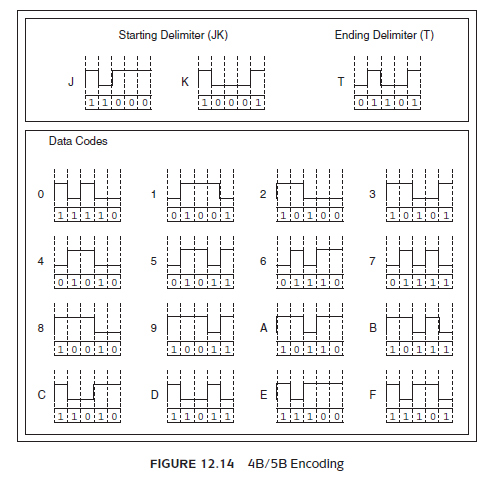
The Essentials Of Computer Organization And Architecture 4th Edition by Linda Null,Julia Lobur
Edition 4ISBN: 978-1284074482
The Essentials Of Computer Organization And Architecture 4th Edition by Linda Null,Julia Lobur
Edition 4ISBN: 978-1284074482 Exercise 31
It looks like the 4B/5B bit cells in Figure 12.14 are fairly small. How long, in reality, is such a bit cell on a 125MHz line? (Use the constants and formulas from the previous question.)
Reference of Figure 12.14:
Reference of Exercise 20:
How big is a physical PDU? The answer to this question determines the number of simultaneous transmissions for many network architectures.
If a signal propagates through copper wire at a rate of 2 × 108m/s, then on a carrier running at 10Mbps the length of each bit pulse is given by:
If a data frame is 512 bits long, then the entire frame occupies: (Length of one bit) ? (Frame size) 5 20 ? 512 5 10,240 meters.
a) How big is a 1,024-bit packet if the network runs at 100Mbps?
b) How big is it if the network speed is increased to 155Mbps?
c) At 100Mbps, how much time elapses as one of these frames passes a particular point in the network?
Reference of Figure 12.14:

Reference of Exercise 20:
How big is a physical PDU? The answer to this question determines the number of simultaneous transmissions for many network architectures.
If a signal propagates through copper wire at a rate of 2 × 108m/s, then on a carrier running at 10Mbps the length of each bit pulse is given by:

If a data frame is 512 bits long, then the entire frame occupies: (Length of one bit) ? (Frame size) 5 20 ? 512 5 10,240 meters.
a) How big is a 1,024-bit packet if the network runs at 100Mbps?
b) How big is it if the network speed is increased to 155Mbps?
c) At 100Mbps, how much time elapses as one of these frames passes a particular point in the network?
Explanation
The OSI Physical layer moves transmissio...
The Essentials Of Computer Organization And Architecture 4th Edition by Linda Null,Julia Lobur
Why don’t you like this exercise?
Other Minimum 8 character and maximum 255 character
Character 255



